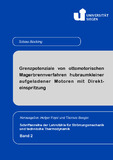Citation link:
https://nbn-resolving.org/urn:nbn:de:hbz:467-9618Files in This Item:
| File | Description | Size | Format | |
|---|---|---|---|---|
| Dissertation_Tobias_Boecking.pdf | 2.4 MB | Adobe PDF |  View/Open |
| Dokument Type: | Doctoral Thesis | metadata.dc.title: | Grenzpotenziale von ottomotorischen Magerbrennverfahren hubraumkleiner aufgeladener Motoren mit Direkteinspritzung | Other Titles: | Potential of a new lean burn process for reducing the CO2 emissions of turbocharged spark ignited engines with direct injection | Authors: | Böcking, Tobias | Institute: | Institut für Fluid- und Thermodynamik | Free keywords: | Magerbetrieb, Ladungsbewegung, variable Ventilsteuerung, strahlgeführte Direkteinspritzung, exhaust gas recirculation, lean burn process, variable valvetrain, charge motion, spray guided direct injection | Dewey Decimal Classification: | 620 Ingenieurwissenschaften und Maschinenbau | GHBS-Clases: | XNT ZOL |
Issue Date: | 2015 | Publish Date: | 2015 | Series/Report no.: | Schriftenreihe der Lehrstühle für Strömungsmechanik und technische Thermodynamik | Abstract: | Die vorliegende Arbeit stellt ein neues kombiniertes Magerbrennverfahren vor und leistet damit einen Beitrag zur Bewertung der Grenzpotenziale von ottomotorischen Magerbrennverfahren hubraumkleiner aufgeladener Ottomotoren mit Direkteinspritzung. Während der stöchiometrische Betrieb des Ottomotors nur noch vergleichsweise wenig Potenzial zur Verringerung des CO2-Ausstoßes bietet, lässt sich der Kraftstoffverbrauch von Ottomotoren durch den überstöchiometrischen Betrieb signifikant reduzieren. Die Kombination des Magerbetriebs – sowohl mit homogener als auch heterogener Gemischaufbereitung – mit Technologien wie z. B. einem variablen Ventiltrieb, einer optimierten Ladungsbewegung, einem innovativen Zündsystem oder einer weiterentwickelten Aufladung birgt enormes Potenzial. Zur Quantifizierung dieses Potenzials wurden nach erfolgter Betrachtung des Stands der Technik und einer entsprechend abgeleiteten Strategie Untersuchungen an diversen Einzylinder- und Vierzylindermotoren durchgeführt, die eine Bewertung einzelner Maßnahmen und deren Kombinationen hinsichtlich des CO2-Potenzials ermöglichen. Die dadurch gewonnen Erkenntnisse lassen sich wie folgt zusammenfassen: - Zur Erschließung des max. CO2-Minderungspotenzials von Ottomotoren ist eine Kombination des homogenen und heterogenen Magerbetriebs im Kennfeld notwendig. - Mit dem Ziel einer Reduzierung des Aufwands seitens der Abgasnachbehandlung sollte der Magerbetrieb mit einer betriebspunktabhängig angepassten Menge an Restgas durch interne Abgasrückführung kombiniert werden. - Eine signifikante Steigerung der Ladungsbewegung ermöglicht sowohl eine deutliche Reduktion der Schadstoffemissionen im Magerbetrieb als auch eine Erweiterung des Kennfeldbereichs, in dem der Verbrauchsvorteil des Magerbetriebs erschlossen werden kann. - Ein hohes Ladungsbewegungsniveau steht dem heterogenen Magerbetrieb des Motors und dem damit verbundenen Verbrauchsvorteil nicht entgegen. Within the scope of this thesis a new lean burn process combining homogeneous and stratified charge combustion for reducing the fuel consumption of turbocharged spark ignited direct injection engines is presented. It is widely recognised that the operation of spark ignited engines with excess air is one of the most promising methods to achieve a large fuel consumption improvement. The combination of lean burn combustion with technologies like for instance a variable valve train, an increased charge motion, an innovative ignition system or an improved turbocharger offers enormous potential for reducing fuel consumption and consequently also CO2 emissions of small capacity engines with turbocharging and direct injection. After considering the current state of scientific knowledge and developing a strategy for achieving a large fuel consumption improvement on the one hand and a reduction of nitrogen oxide emissions on the other hand experimental investigations on diverse single- and four-cylinder engines were carried out in order to quantify these potentials. The findings can be summarised as follows: - By combining the homogeneous-lean, homogeneous stratified and the strat ified charge combustion in one engine map a significant benefit in fuel consumption can be achieved. - To limit the additional expenses regarding the exhaust gas aftertreatment the engine-out nitrogen oxide emissions have to be reduced. Therefore, the dilution of the mixture has to be maximised. Depending on the engine operation point, the residual-gas/ air mixture should be adjusted. - A significantly increased charge motion allows a reduction of pollutant emissions in lean operation as well as an expansion of the engine load range operated so far. - A high level of charge motion does not conflict with the stratified charge combustion at low part load in general. |
URN: | urn:nbn:de:hbz:467-9618 | URI: | https://dspace.ub.uni-siegen.de/handle/ubsi/961 | License: | https://dspace.ub.uni-siegen.de/static/license.txt |
| Appears in Collections: | Hochschulschriften |
This item is protected by original copyright |
Page view(s)
818
checked on Apr 3, 2025
Download(s)
1,117
checked on Apr 3, 2025
Google ScholarTM
Check
Items in DSpace are protected by copyright, with all rights reserved, unless otherwise indicated.

